Managing People in Organisations: Study Material and Solved Assignments
VerifiedAdded on 2023/06/12
|15
|3290
|123
AI Summary
This report contains a reflective account of the learnings done throughout the course of 10 weeks on Managing People in Organisations. It covers topics such as recruitment methods, selection methods, equality, diversity and inclusion, skills, training and development, performance management, academic writing, referencing and plagiarism, motivation and rewards, the psychological contract and employee engagement, and international differences in organisations and management. The report includes questions and answers, definitions, and recommendations for each topic.
Contribute Materials
Your contribution can guide someone’s learning journey. Share your
documents today.
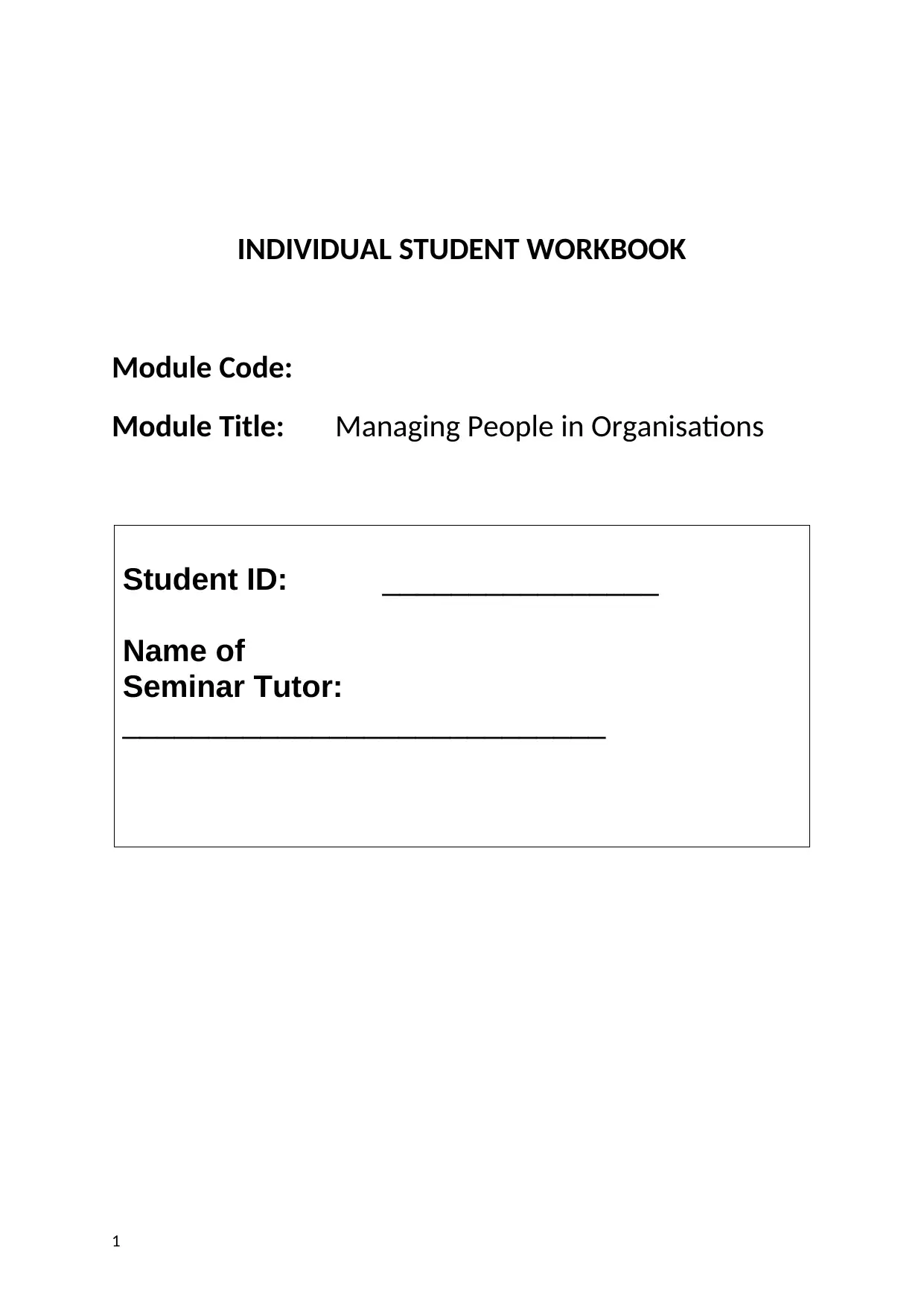
INDIVIDUAL STUDENT WORKBOOK
Module Code:
Module Title: Managing People in Organisations
Student ID: ________________
Name of
Seminar Tutor:
____________________________
1
Module Code:
Module Title: Managing People in Organisations
Student ID: ________________
Name of
Seminar Tutor:
____________________________
1
Secure Best Marks with AI Grader
Need help grading? Try our AI Grader for instant feedback on your assignments.
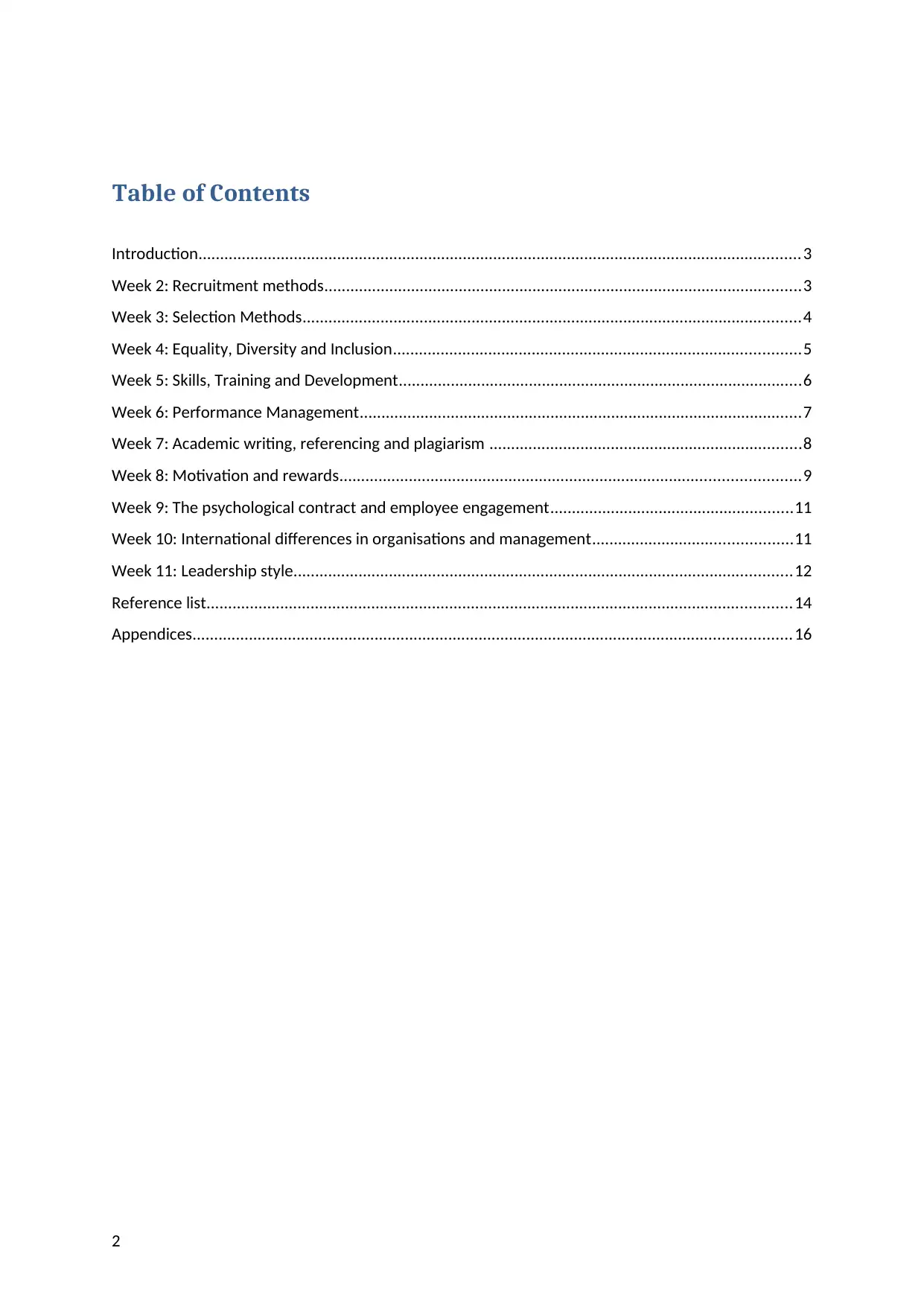
Table of Contents
Introduction...........................................................................................................................................3
Week 2: Recruitment methods..............................................................................................................3
Week 3: Selection Methods...................................................................................................................4
Week 4: Equality, Diversity and Inclusion..............................................................................................5
Week 5: Skills, Training and Development.............................................................................................6
Week 6: Performance Management......................................................................................................7
Week 7: Academic writing, referencing and plagiarism ........................................................................8
Week 8: Motivation and rewards..........................................................................................................9
Week 9: The psychological contract and employee engagement........................................................11
Week 10: International differences in organisations and management..............................................11
Week 11: Leadership style...................................................................................................................12
Reference list.......................................................................................................................................14
Appendices..........................................................................................................................................16
2
Introduction...........................................................................................................................................3
Week 2: Recruitment methods..............................................................................................................3
Week 3: Selection Methods...................................................................................................................4
Week 4: Equality, Diversity and Inclusion..............................................................................................5
Week 5: Skills, Training and Development.............................................................................................6
Week 6: Performance Management......................................................................................................7
Week 7: Academic writing, referencing and plagiarism ........................................................................8
Week 8: Motivation and rewards..........................................................................................................9
Week 9: The psychological contract and employee engagement........................................................11
Week 10: International differences in organisations and management..............................................11
Week 11: Leadership style...................................................................................................................12
Reference list.......................................................................................................................................14
Appendices..........................................................................................................................................16
2
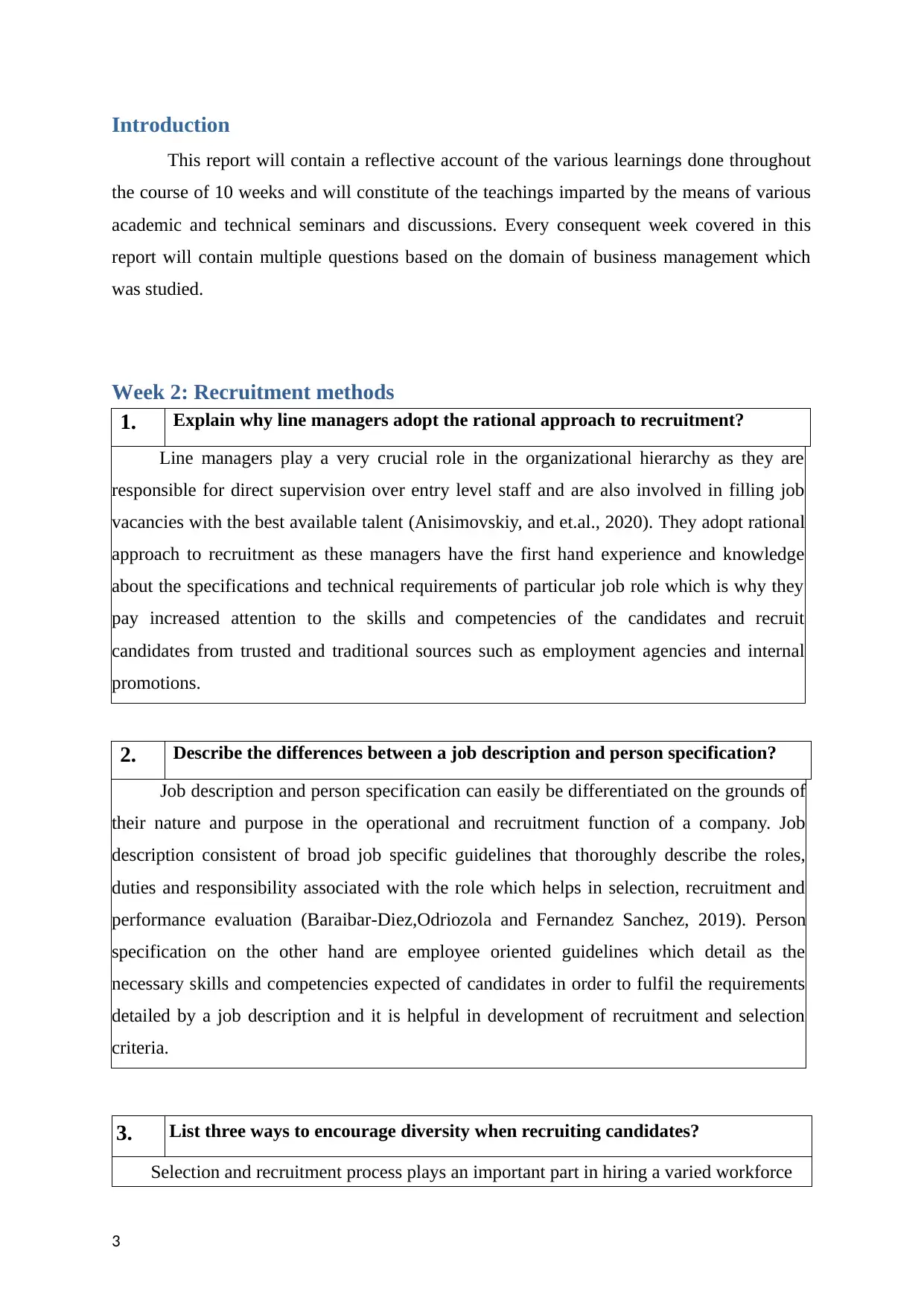
Introduction
This report will contain a reflective account of the various learnings done throughout
the course of 10 weeks and will constitute of the teachings imparted by the means of various
academic and technical seminars and discussions. Every consequent week covered in this
report will contain multiple questions based on the domain of business management which
was studied.
Week 2: Recruitment methods
1. Explain why line managers adopt the rational approach to recruitment?
Line managers play a very crucial role in the organizational hierarchy as they are
responsible for direct supervision over entry level staff and are also involved in filling job
vacancies with the best available talent (Anisimovskiy, and et.al., 2020). They adopt rational
approach to recruitment as these managers have the first hand experience and knowledge
about the specifications and technical requirements of particular job role which is why they
pay increased attention to the skills and competencies of the candidates and recruit
candidates from trusted and traditional sources such as employment agencies and internal
promotions.
2. Describe the differences between a job description and person specification?
Job description and person specification can easily be differentiated on the grounds of
their nature and purpose in the operational and recruitment function of a company. Job
description consistent of broad job specific guidelines that thoroughly describe the roles,
duties and responsibility associated with the role which helps in selection, recruitment and
performance evaluation (Baraibar‐Diez,Odriozola and Fernandez Sanchez, 2019). Person
specification on the other hand are employee oriented guidelines which detail as the
necessary skills and competencies expected of candidates in order to fulfil the requirements
detailed by a job description and it is helpful in development of recruitment and selection
criteria.
3. List three ways to encourage diversity when recruiting candidates?
Selection and recruitment process plays an important part in hiring a varied workforce
3
This report will contain a reflective account of the various learnings done throughout
the course of 10 weeks and will constitute of the teachings imparted by the means of various
academic and technical seminars and discussions. Every consequent week covered in this
report will contain multiple questions based on the domain of business management which
was studied.
Week 2: Recruitment methods
1. Explain why line managers adopt the rational approach to recruitment?
Line managers play a very crucial role in the organizational hierarchy as they are
responsible for direct supervision over entry level staff and are also involved in filling job
vacancies with the best available talent (Anisimovskiy, and et.al., 2020). They adopt rational
approach to recruitment as these managers have the first hand experience and knowledge
about the specifications and technical requirements of particular job role which is why they
pay increased attention to the skills and competencies of the candidates and recruit
candidates from trusted and traditional sources such as employment agencies and internal
promotions.
2. Describe the differences between a job description and person specification?
Job description and person specification can easily be differentiated on the grounds of
their nature and purpose in the operational and recruitment function of a company. Job
description consistent of broad job specific guidelines that thoroughly describe the roles,
duties and responsibility associated with the role which helps in selection, recruitment and
performance evaluation (Baraibar‐Diez,Odriozola and Fernandez Sanchez, 2019). Person
specification on the other hand are employee oriented guidelines which detail as the
necessary skills and competencies expected of candidates in order to fulfil the requirements
detailed by a job description and it is helpful in development of recruitment and selection
criteria.
3. List three ways to encourage diversity when recruiting candidates?
Selection and recruitment process plays an important part in hiring a varied workforce
3
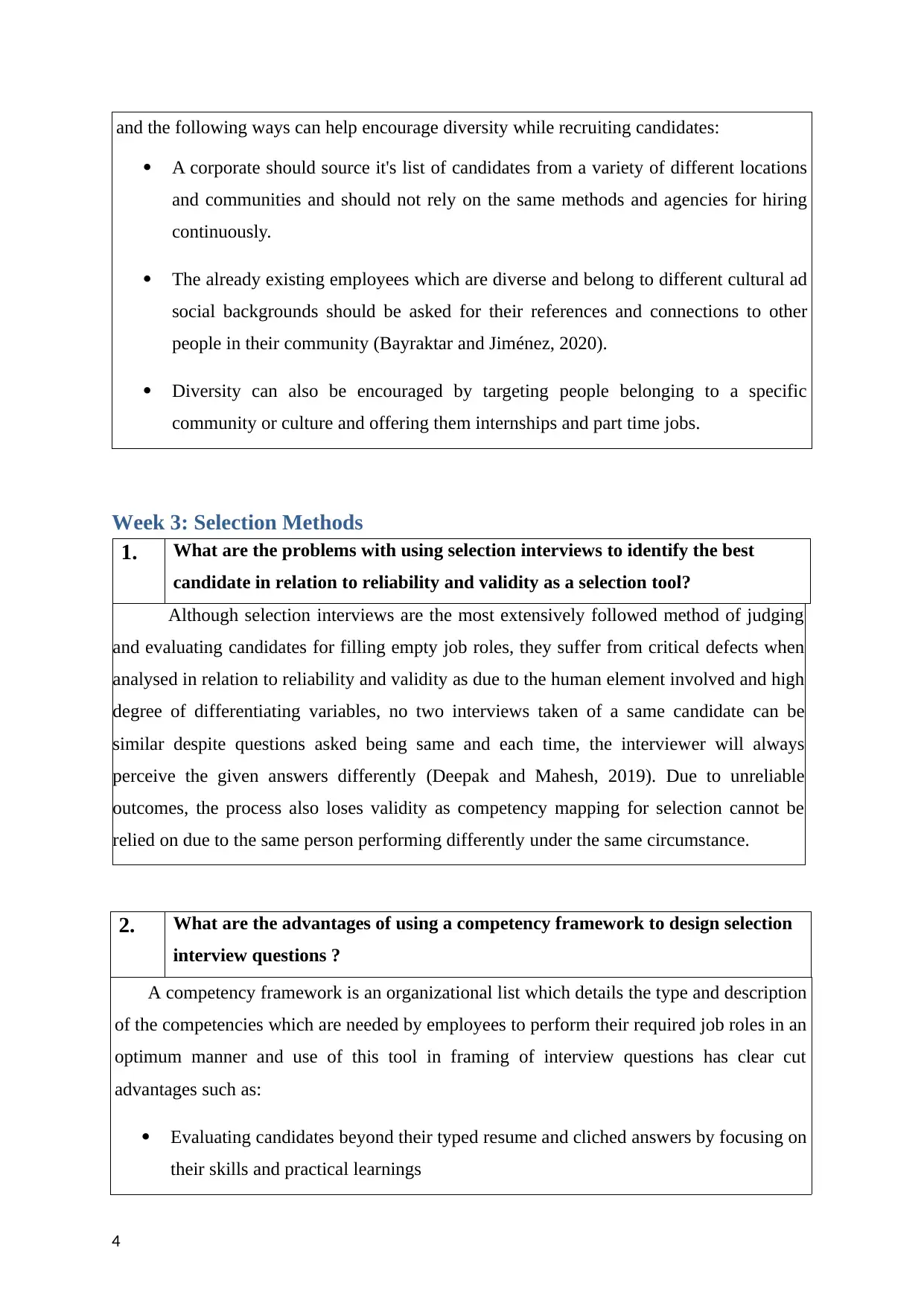
and the following ways can help encourage diversity while recruiting candidates:
A corporate should source it's list of candidates from a variety of different locations
and communities and should not rely on the same methods and agencies for hiring
continuously.
The already existing employees which are diverse and belong to different cultural ad
social backgrounds should be asked for their references and connections to other
people in their community (Bayraktar and Jiménez, 2020).
Diversity can also be encouraged by targeting people belonging to a specific
community or culture and offering them internships and part time jobs.
Week 3: Selection Methods
1. What are the problems with using selection interviews to identify the best
candidate in relation to reliability and validity as a selection tool?
Although selection interviews are the most extensively followed method of judging
and evaluating candidates for filling empty job roles, they suffer from critical defects when
analysed in relation to reliability and validity as due to the human element involved and high
degree of differentiating variables, no two interviews taken of a same candidate can be
similar despite questions asked being same and each time, the interviewer will always
perceive the given answers differently (Deepak and Mahesh, 2019). Due to unreliable
outcomes, the process also loses validity as competency mapping for selection cannot be
relied on due to the same person performing differently under the same circumstance.
2. What are the advantages of using a competency framework to design selection
interview questions ?
A competency framework is an organizational list which details the type and description
of the competencies which are needed by employees to perform their required job roles in an
optimum manner and use of this tool in framing of interview questions has clear cut
advantages such as:
Evaluating candidates beyond their typed resume and cliched answers by focusing on
their skills and practical learnings
4
A corporate should source it's list of candidates from a variety of different locations
and communities and should not rely on the same methods and agencies for hiring
continuously.
The already existing employees which are diverse and belong to different cultural ad
social backgrounds should be asked for their references and connections to other
people in their community (Bayraktar and Jiménez, 2020).
Diversity can also be encouraged by targeting people belonging to a specific
community or culture and offering them internships and part time jobs.
Week 3: Selection Methods
1. What are the problems with using selection interviews to identify the best
candidate in relation to reliability and validity as a selection tool?
Although selection interviews are the most extensively followed method of judging
and evaluating candidates for filling empty job roles, they suffer from critical defects when
analysed in relation to reliability and validity as due to the human element involved and high
degree of differentiating variables, no two interviews taken of a same candidate can be
similar despite questions asked being same and each time, the interviewer will always
perceive the given answers differently (Deepak and Mahesh, 2019). Due to unreliable
outcomes, the process also loses validity as competency mapping for selection cannot be
relied on due to the same person performing differently under the same circumstance.
2. What are the advantages of using a competency framework to design selection
interview questions ?
A competency framework is an organizational list which details the type and description
of the competencies which are needed by employees to perform their required job roles in an
optimum manner and use of this tool in framing of interview questions has clear cut
advantages such as:
Evaluating candidates beyond their typed resume and cliched answers by focusing on
their skills and practical learnings
4
Secure Best Marks with AI Grader
Need help grading? Try our AI Grader for instant feedback on your assignments.
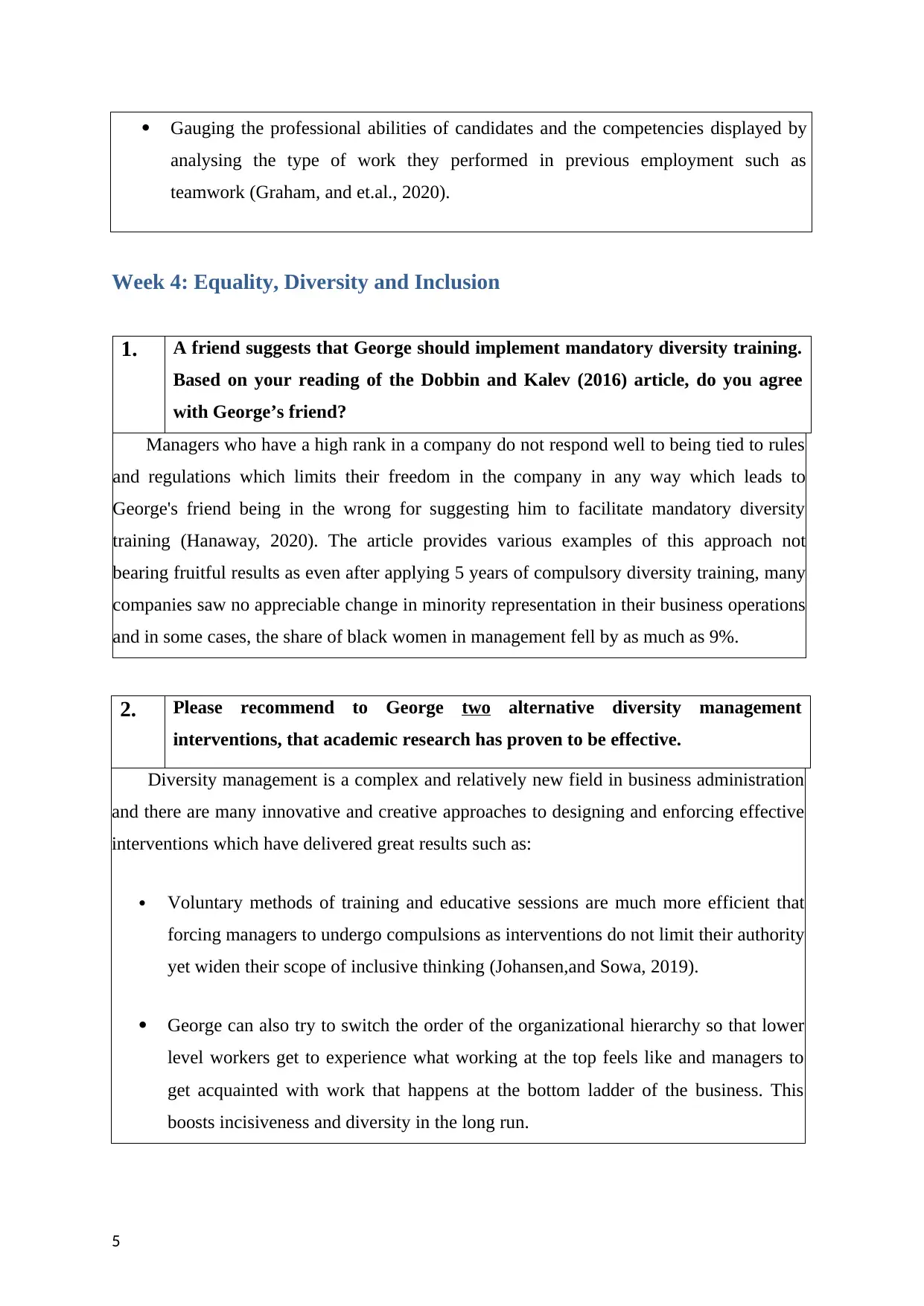
Gauging the professional abilities of candidates and the competencies displayed by
analysing the type of work they performed in previous employment such as
teamwork (Graham, and et.al., 2020).
Week 4: Equality, Diversity and Inclusion
1. A friend suggests that George should implement mandatory diversity training.
Based on your reading of the Dobbin and Kalev (2016) article, do you agree
with George’s friend?
Managers who have a high rank in a company do not respond well to being tied to rules
and regulations which limits their freedom in the company in any way which leads to
George's friend being in the wrong for suggesting him to facilitate mandatory diversity
training (Hanaway, 2020). The article provides various examples of this approach not
bearing fruitful results as even after applying 5 years of compulsory diversity training, many
companies saw no appreciable change in minority representation in their business operations
and in some cases, the share of black women in management fell by as much as 9%.
2. Please recommend to George two alternative diversity management
interventions, that academic research has proven to be effective.
Diversity management is a complex and relatively new field in business administration
and there are many innovative and creative approaches to designing and enforcing effective
interventions which have delivered great results such as:
Voluntary methods of training and educative sessions are much more efficient that
forcing managers to undergo compulsions as interventions do not limit their authority
yet widen their scope of inclusive thinking (Johansen,and Sowa, 2019).
George can also try to switch the order of the organizational hierarchy so that lower
level workers get to experience what working at the top feels like and managers to
get acquainted with work that happens at the bottom ladder of the business. This
boosts incisiveness and diversity in the long run.
5
analysing the type of work they performed in previous employment such as
teamwork (Graham, and et.al., 2020).
Week 4: Equality, Diversity and Inclusion
1. A friend suggests that George should implement mandatory diversity training.
Based on your reading of the Dobbin and Kalev (2016) article, do you agree
with George’s friend?
Managers who have a high rank in a company do not respond well to being tied to rules
and regulations which limits their freedom in the company in any way which leads to
George's friend being in the wrong for suggesting him to facilitate mandatory diversity
training (Hanaway, 2020). The article provides various examples of this approach not
bearing fruitful results as even after applying 5 years of compulsory diversity training, many
companies saw no appreciable change in minority representation in their business operations
and in some cases, the share of black women in management fell by as much as 9%.
2. Please recommend to George two alternative diversity management
interventions, that academic research has proven to be effective.
Diversity management is a complex and relatively new field in business administration
and there are many innovative and creative approaches to designing and enforcing effective
interventions which have delivered great results such as:
Voluntary methods of training and educative sessions are much more efficient that
forcing managers to undergo compulsions as interventions do not limit their authority
yet widen their scope of inclusive thinking (Johansen,and Sowa, 2019).
George can also try to switch the order of the organizational hierarchy so that lower
level workers get to experience what working at the top feels like and managers to
get acquainted with work that happens at the bottom ladder of the business. This
boosts incisiveness and diversity in the long run.
5
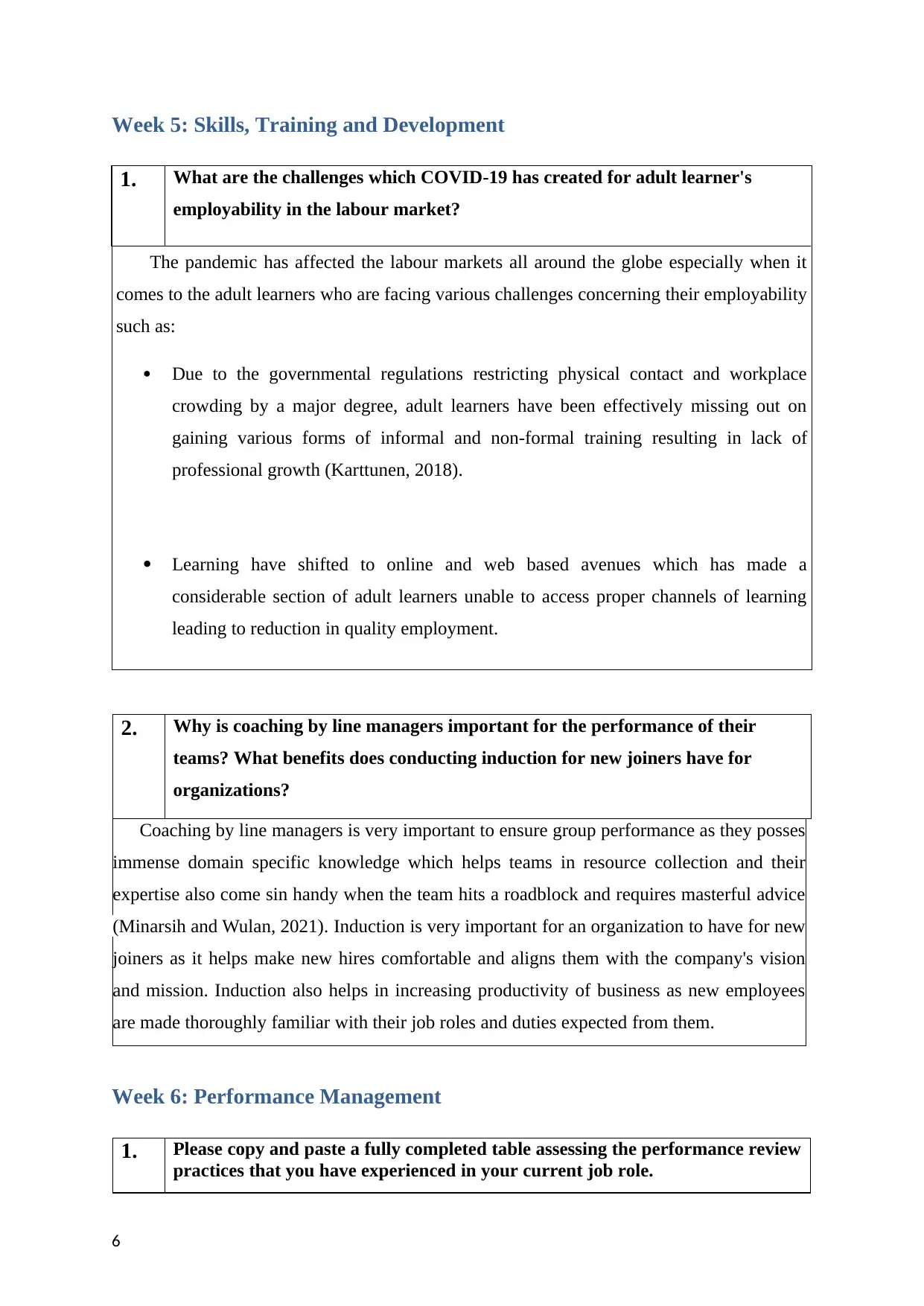
Week 5: Skills, Training and Development
1. What are the challenges which COVID-19 has created for adult learner's
employability in the labour market?
The pandemic has affected the labour markets all around the globe especially when it
comes to the adult learners who are facing various challenges concerning their employability
such as:
Due to the governmental regulations restricting physical contact and workplace
crowding by a major degree, adult learners have been effectively missing out on
gaining various forms of informal and non-formal training resulting in lack of
professional growth (Karttunen, 2018).
Learning have shifted to online and web based avenues which has made a
considerable section of adult learners unable to access proper channels of learning
leading to reduction in quality employment.
2. Why is coaching by line managers important for the performance of their
teams? What benefits does conducting induction for new joiners have for
organizations?
Coaching by line managers is very important to ensure group performance as they posses
immense domain specific knowledge which helps teams in resource collection and their
expertise also come sin handy when the team hits a roadblock and requires masterful advice
(Minarsih and Wulan, 2021). Induction is very important for an organization to have for new
joiners as it helps make new hires comfortable and aligns them with the company's vision
and mission. Induction also helps in increasing productivity of business as new employees
are made thoroughly familiar with their job roles and duties expected from them.
Week 6: Performance Management
1. Please copy and paste a fully completed table assessing the performance review
practices that you have experienced in your current job role.
6
1. What are the challenges which COVID-19 has created for adult learner's
employability in the labour market?
The pandemic has affected the labour markets all around the globe especially when it
comes to the adult learners who are facing various challenges concerning their employability
such as:
Due to the governmental regulations restricting physical contact and workplace
crowding by a major degree, adult learners have been effectively missing out on
gaining various forms of informal and non-formal training resulting in lack of
professional growth (Karttunen, 2018).
Learning have shifted to online and web based avenues which has made a
considerable section of adult learners unable to access proper channels of learning
leading to reduction in quality employment.
2. Why is coaching by line managers important for the performance of their
teams? What benefits does conducting induction for new joiners have for
organizations?
Coaching by line managers is very important to ensure group performance as they posses
immense domain specific knowledge which helps teams in resource collection and their
expertise also come sin handy when the team hits a roadblock and requires masterful advice
(Minarsih and Wulan, 2021). Induction is very important for an organization to have for new
joiners as it helps make new hires comfortable and aligns them with the company's vision
and mission. Induction also helps in increasing productivity of business as new employees
are made thoroughly familiar with their job roles and duties expected from them.
Week 6: Performance Management
1. Please copy and paste a fully completed table assessing the performance review
practices that you have experienced in your current job role.
6
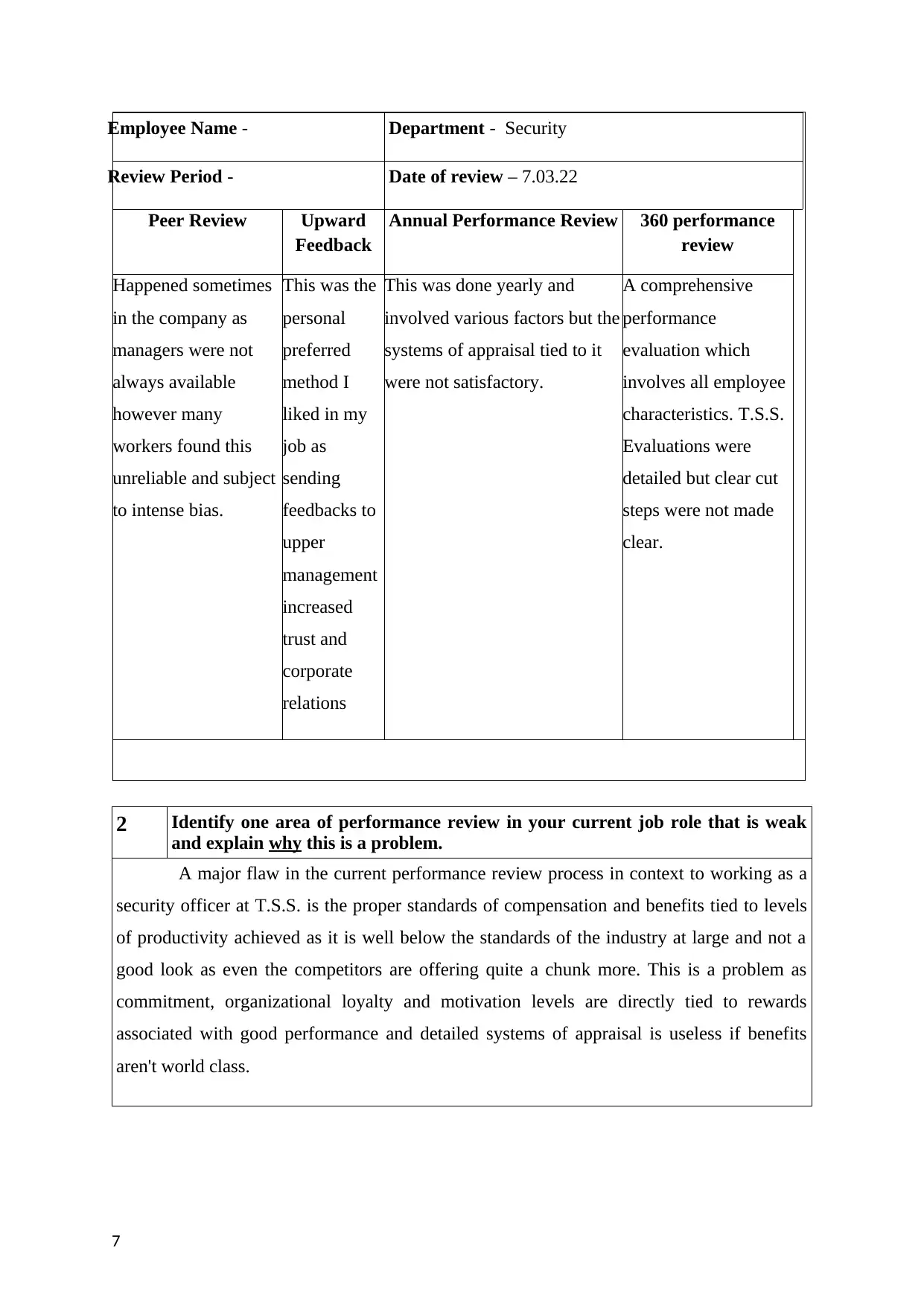
Employee Name - Department - Security
Review Period - Date of review – 7.03.22
Peer Review Upward
Feedback
Annual Performance Review 360 performance
review
Happened sometimes
in the company as
managers were not
always available
however many
workers found this
unreliable and subject
to intense bias.
This was the
personal
preferred
method I
liked in my
job as
sending
feedbacks to
upper
management
increased
trust and
corporate
relations
This was done yearly and
involved various factors but the
systems of appraisal tied to it
were not satisfactory.
A comprehensive
performance
evaluation which
involves all employee
characteristics. T.S.S.
Evaluations were
detailed but clear cut
steps were not made
clear.
2 Identify one area of performance review in your current job role that is weak
and explain why this is a problem.
A major flaw in the current performance review process in context to working as a
security officer at T.S.S. is the proper standards of compensation and benefits tied to levels
of productivity achieved as it is well below the standards of the industry at large and not a
good look as even the competitors are offering quite a chunk more. This is a problem as
commitment, organizational loyalty and motivation levels are directly tied to rewards
associated with good performance and detailed systems of appraisal is useless if benefits
aren't world class.
7
Review Period - Date of review – 7.03.22
Peer Review Upward
Feedback
Annual Performance Review 360 performance
review
Happened sometimes
in the company as
managers were not
always available
however many
workers found this
unreliable and subject
to intense bias.
This was the
personal
preferred
method I
liked in my
job as
sending
feedbacks to
upper
management
increased
trust and
corporate
relations
This was done yearly and
involved various factors but the
systems of appraisal tied to it
were not satisfactory.
A comprehensive
performance
evaluation which
involves all employee
characteristics. T.S.S.
Evaluations were
detailed but clear cut
steps were not made
clear.
2 Identify one area of performance review in your current job role that is weak
and explain why this is a problem.
A major flaw in the current performance review process in context to working as a
security officer at T.S.S. is the proper standards of compensation and benefits tied to levels
of productivity achieved as it is well below the standards of the industry at large and not a
good look as even the competitors are offering quite a chunk more. This is a problem as
commitment, organizational loyalty and motivation levels are directly tied to rewards
associated with good performance and detailed systems of appraisal is useless if benefits
aren't world class.
7
Paraphrase This Document
Need a fresh take? Get an instant paraphrase of this document with our AI Paraphraser
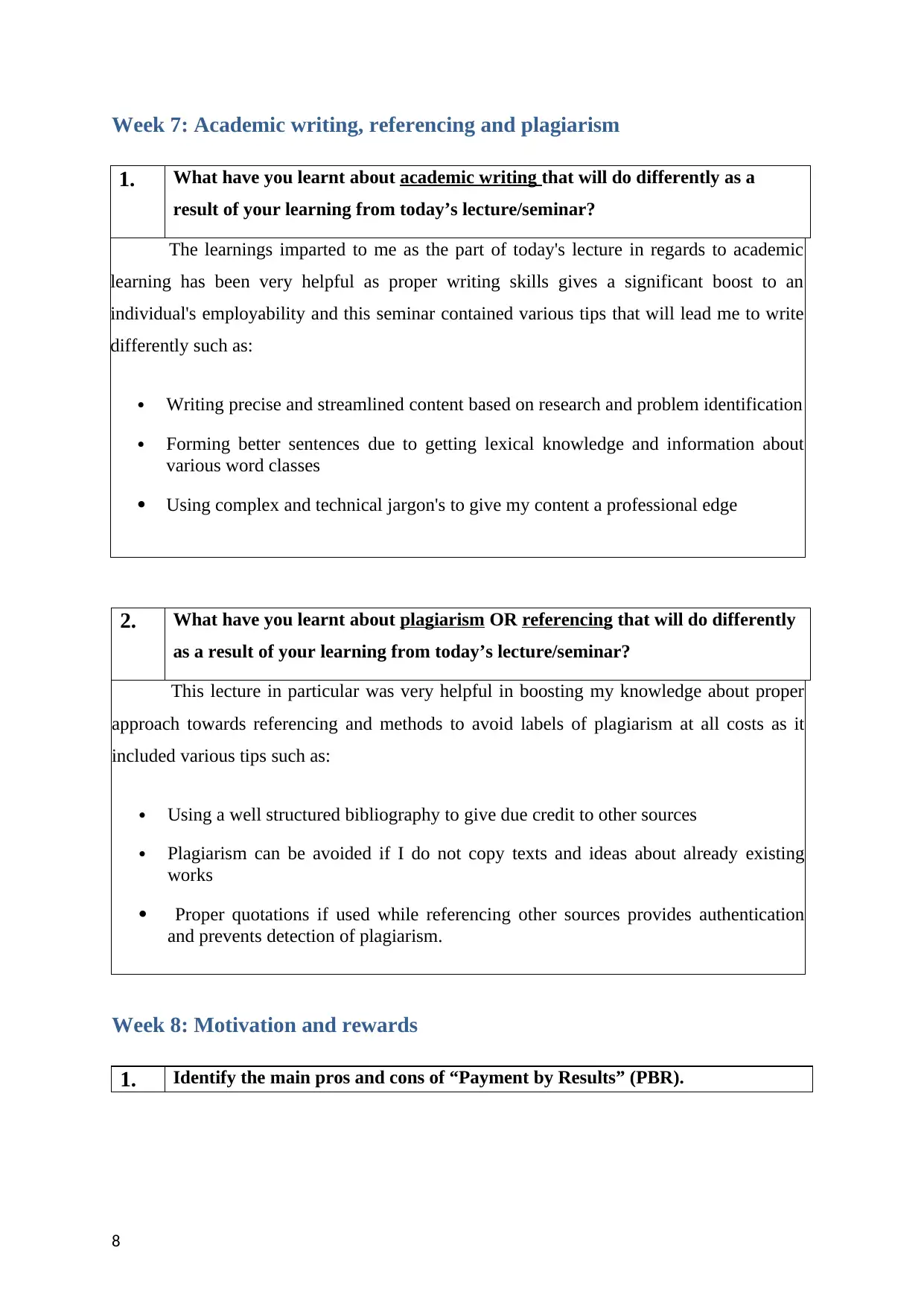
Week 7: Academic writing, referencing and plagiarism
1. What have you learnt about academic writing that will do differently as a
result of your learning from today’s lecture/seminar?
The learnings imparted to me as the part of today's lecture in regards to academic
learning has been very helpful as proper writing skills gives a significant boost to an
individual's employability and this seminar contained various tips that will lead me to write
differently such as:
Writing precise and streamlined content based on research and problem identification
Forming better sentences due to getting lexical knowledge and information about
various word classes
Using complex and technical jargon's to give my content a professional edge
2. What have you learnt about plagiarism OR referencing that will do differently
as a result of your learning from today’s lecture/seminar?
This lecture in particular was very helpful in boosting my knowledge about proper
approach towards referencing and methods to avoid labels of plagiarism at all costs as it
included various tips such as:
Using a well structured bibliography to give due credit to other sources
Plagiarism can be avoided if I do not copy texts and ideas about already existing
works
Proper quotations if used while referencing other sources provides authentication
and prevents detection of plagiarism.
Week 8: Motivation and rewards
1. Identify the main pros and cons of “Payment by Results” (PBR).
8
1. What have you learnt about academic writing that will do differently as a
result of your learning from today’s lecture/seminar?
The learnings imparted to me as the part of today's lecture in regards to academic
learning has been very helpful as proper writing skills gives a significant boost to an
individual's employability and this seminar contained various tips that will lead me to write
differently such as:
Writing precise and streamlined content based on research and problem identification
Forming better sentences due to getting lexical knowledge and information about
various word classes
Using complex and technical jargon's to give my content a professional edge
2. What have you learnt about plagiarism OR referencing that will do differently
as a result of your learning from today’s lecture/seminar?
This lecture in particular was very helpful in boosting my knowledge about proper
approach towards referencing and methods to avoid labels of plagiarism at all costs as it
included various tips such as:
Using a well structured bibliography to give due credit to other sources
Plagiarism can be avoided if I do not copy texts and ideas about already existing
works
Proper quotations if used while referencing other sources provides authentication
and prevents detection of plagiarism.
Week 8: Motivation and rewards
1. Identify the main pros and cons of “Payment by Results” (PBR).
8
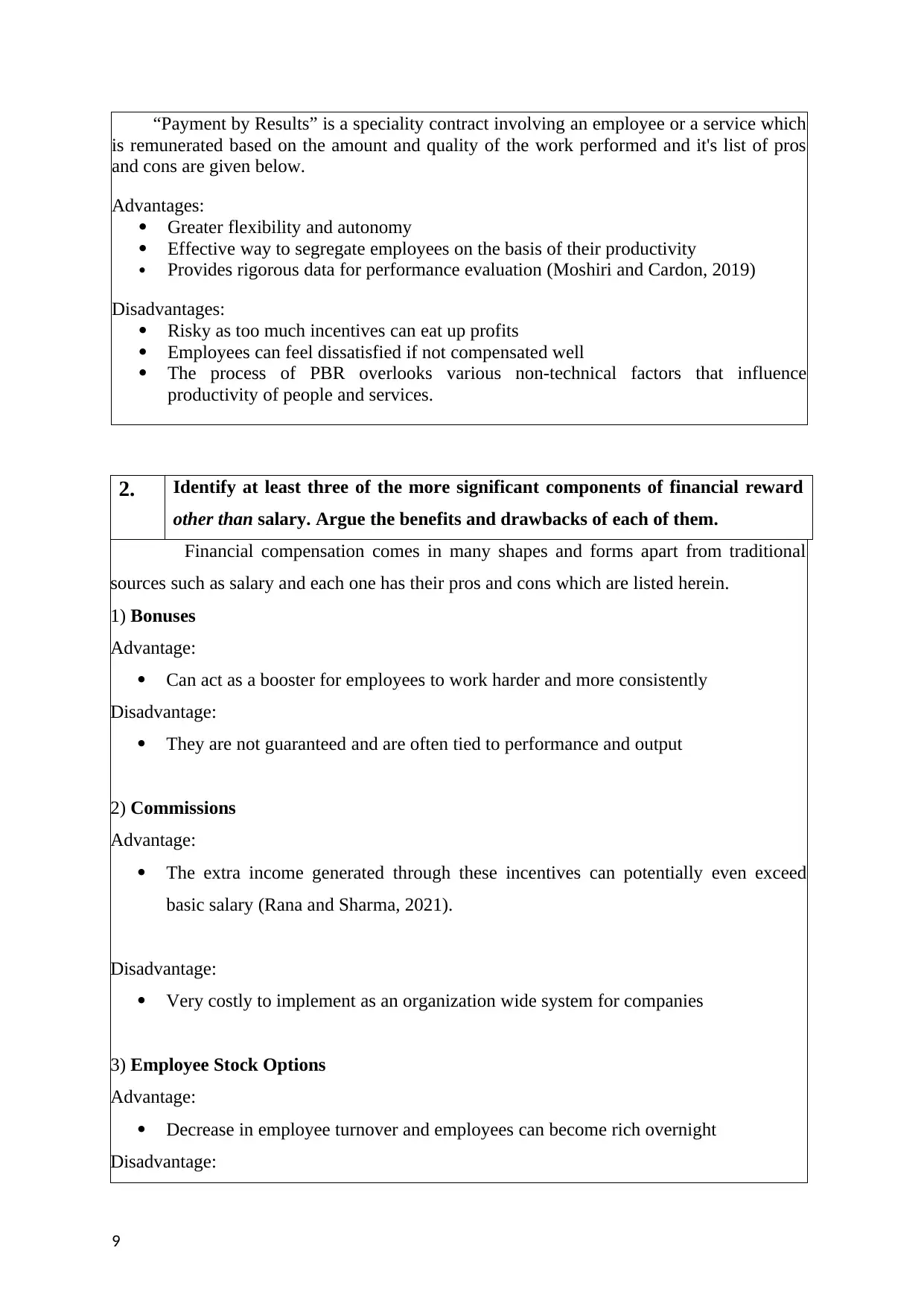
“Payment by Results” is a speciality contract involving an employee or a service which
is remunerated based on the amount and quality of the work performed and it's list of pros
and cons are given below.
Advantages:
Greater flexibility and autonomy
Effective way to segregate employees on the basis of their productivity
Provides rigorous data for performance evaluation (Moshiri and Cardon, 2019)
Disadvantages:
Risky as too much incentives can eat up profits
Employees can feel dissatisfied if not compensated well
The process of PBR overlooks various non-technical factors that influence
productivity of people and services.
2. Identify at least three of the more significant components of financial reward
other than salary. Argue the benefits and drawbacks of each of them.
Financial compensation comes in many shapes and forms apart from traditional
sources such as salary and each one has their pros and cons which are listed herein.
1) Bonuses
Advantage:
Can act as a booster for employees to work harder and more consistently
Disadvantage:
They are not guaranteed and are often tied to performance and output
2) Commissions
Advantage:
The extra income generated through these incentives can potentially even exceed
basic salary (Rana and Sharma, 2021).
Disadvantage:
Very costly to implement as an organization wide system for companies
3) Employee Stock Options
Advantage:
Decrease in employee turnover and employees can become rich overnight
Disadvantage:
9
is remunerated based on the amount and quality of the work performed and it's list of pros
and cons are given below.
Advantages:
Greater flexibility and autonomy
Effective way to segregate employees on the basis of their productivity
Provides rigorous data for performance evaluation (Moshiri and Cardon, 2019)
Disadvantages:
Risky as too much incentives can eat up profits
Employees can feel dissatisfied if not compensated well
The process of PBR overlooks various non-technical factors that influence
productivity of people and services.
2. Identify at least three of the more significant components of financial reward
other than salary. Argue the benefits and drawbacks of each of them.
Financial compensation comes in many shapes and forms apart from traditional
sources such as salary and each one has their pros and cons which are listed herein.
1) Bonuses
Advantage:
Can act as a booster for employees to work harder and more consistently
Disadvantage:
They are not guaranteed and are often tied to performance and output
2) Commissions
Advantage:
The extra income generated through these incentives can potentially even exceed
basic salary (Rana and Sharma, 2021).
Disadvantage:
Very costly to implement as an organization wide system for companies
3) Employee Stock Options
Advantage:
Decrease in employee turnover and employees can become rich overnight
Disadvantage:
9
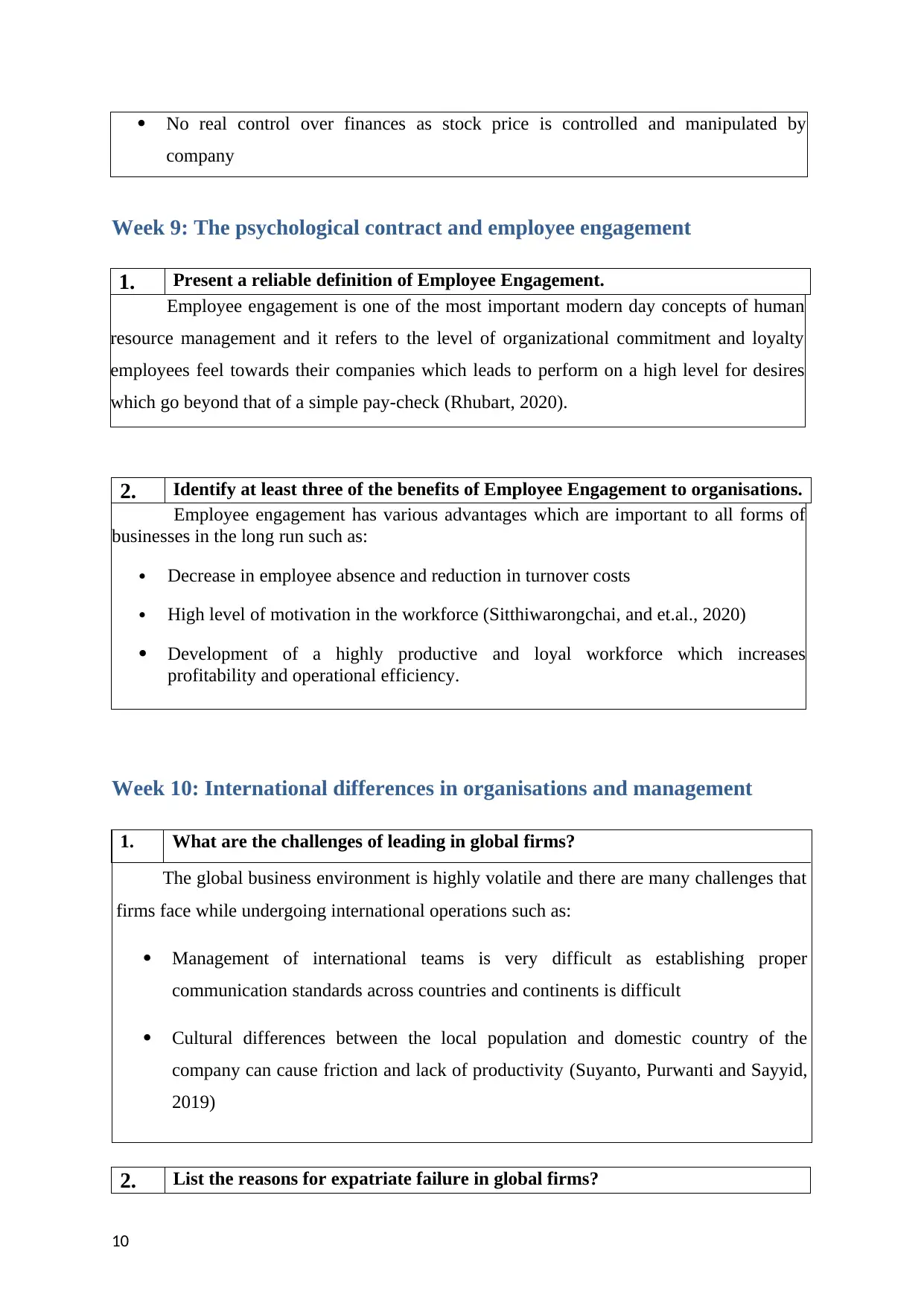
No real control over finances as stock price is controlled and manipulated by
company
Week 9: The psychological contract and employee engagement
1. Present a reliable definition of Employee Engagement.
Employee engagement is one of the most important modern day concepts of human
resource management and it refers to the level of organizational commitment and loyalty
employees feel towards their companies which leads to perform on a high level for desires
which go beyond that of a simple pay-check (Rhubart, 2020).
2. Identify at least three of the benefits of Employee Engagement to organisations.
Employee engagement has various advantages which are important to all forms of
businesses in the long run such as:
Decrease in employee absence and reduction in turnover costs
High level of motivation in the workforce (Sitthiwarongchai, and et.al., 2020)
Development of a highly productive and loyal workforce which increases
profitability and operational efficiency.
Week 10: International differences in organisations and management
1. What are the challenges of leading in global firms?
The global business environment is highly volatile and there are many challenges that
firms face while undergoing international operations such as:
Management of international teams is very difficult as establishing proper
communication standards across countries and continents is difficult
Cultural differences between the local population and domestic country of the
company can cause friction and lack of productivity (Suyanto, Purwanti and Sayyid,
2019)
2. List the reasons for expatriate failure in global firms?
10
company
Week 9: The psychological contract and employee engagement
1. Present a reliable definition of Employee Engagement.
Employee engagement is one of the most important modern day concepts of human
resource management and it refers to the level of organizational commitment and loyalty
employees feel towards their companies which leads to perform on a high level for desires
which go beyond that of a simple pay-check (Rhubart, 2020).
2. Identify at least three of the benefits of Employee Engagement to organisations.
Employee engagement has various advantages which are important to all forms of
businesses in the long run such as:
Decrease in employee absence and reduction in turnover costs
High level of motivation in the workforce (Sitthiwarongchai, and et.al., 2020)
Development of a highly productive and loyal workforce which increases
profitability and operational efficiency.
Week 10: International differences in organisations and management
1. What are the challenges of leading in global firms?
The global business environment is highly volatile and there are many challenges that
firms face while undergoing international operations such as:
Management of international teams is very difficult as establishing proper
communication standards across countries and continents is difficult
Cultural differences between the local population and domestic country of the
company can cause friction and lack of productivity (Suyanto, Purwanti and Sayyid,
2019)
2. List the reasons for expatriate failure in global firms?
10
Secure Best Marks with AI Grader
Need help grading? Try our AI Grader for instant feedback on your assignments.
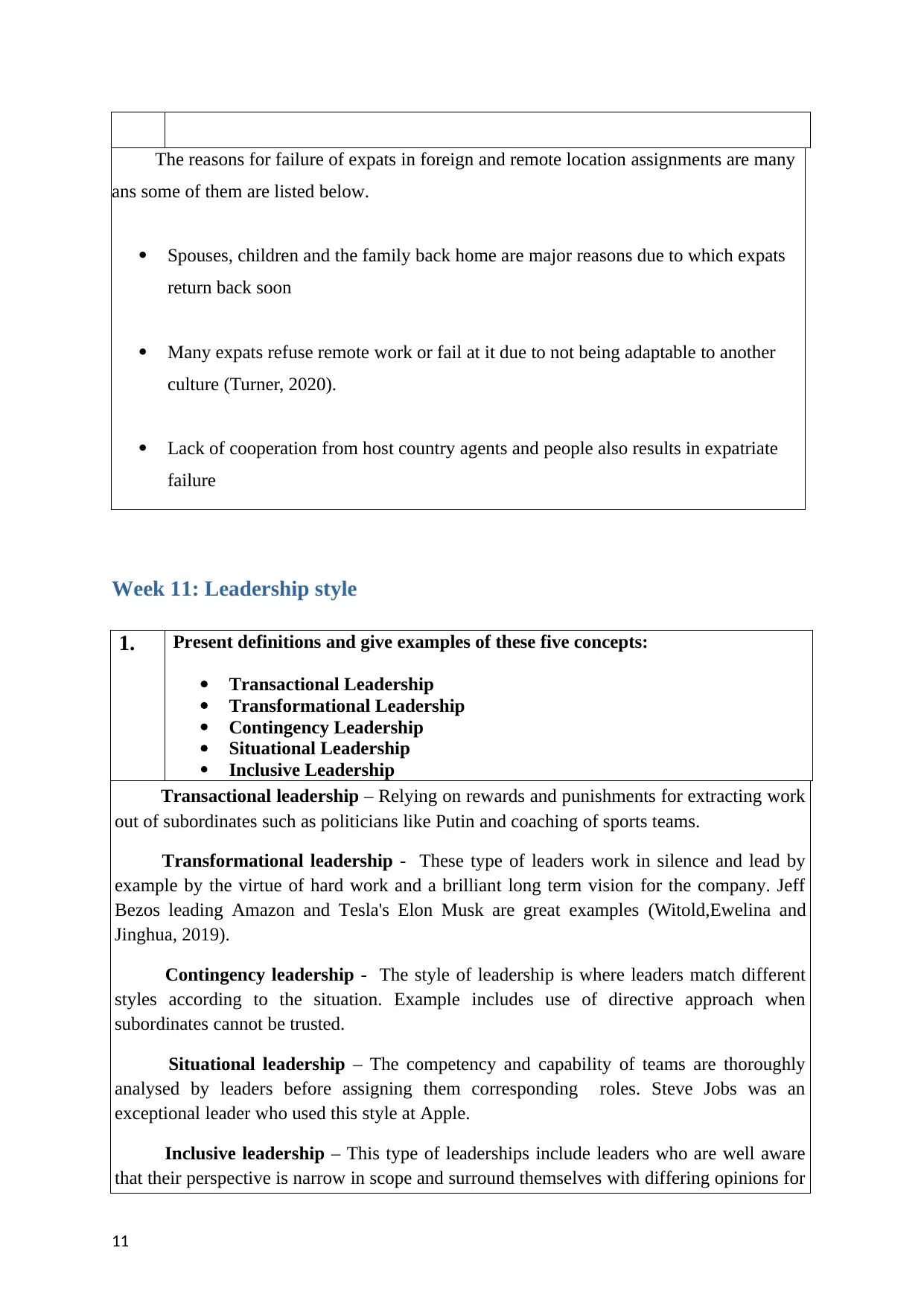
The reasons for failure of expats in foreign and remote location assignments are many
ans some of them are listed below.
Spouses, children and the family back home are major reasons due to which expats
return back soon
Many expats refuse remote work or fail at it due to not being adaptable to another
culture (Turner, 2020).
Lack of cooperation from host country agents and people also results in expatriate
failure
Week 11: Leadership style
1. Present definitions and give examples of these five concepts:
Transactional Leadership
Transformational Leadership
Contingency Leadership
Situational Leadership
Inclusive Leadership
Transactional leadership – Relying on rewards and punishments for extracting work
out of subordinates such as politicians like Putin and coaching of sports teams.
Transformational leadership - These type of leaders work in silence and lead by
example by the virtue of hard work and a brilliant long term vision for the company. Jeff
Bezos leading Amazon and Tesla's Elon Musk are great examples (Witold,Ewelina and
Jinghua, 2019).
Contingency leadership - The style of leadership is where leaders match different
styles according to the situation. Example includes use of directive approach when
subordinates cannot be trusted.
Situational leadership – The competency and capability of teams are thoroughly
analysed by leaders before assigning them corresponding roles. Steve Jobs was an
exceptional leader who used this style at Apple.
Inclusive leadership – This type of leaderships include leaders who are well aware
that their perspective is narrow in scope and surround themselves with differing opinions for
11
ans some of them are listed below.
Spouses, children and the family back home are major reasons due to which expats
return back soon
Many expats refuse remote work or fail at it due to not being adaptable to another
culture (Turner, 2020).
Lack of cooperation from host country agents and people also results in expatriate
failure
Week 11: Leadership style
1. Present definitions and give examples of these five concepts:
Transactional Leadership
Transformational Leadership
Contingency Leadership
Situational Leadership
Inclusive Leadership
Transactional leadership – Relying on rewards and punishments for extracting work
out of subordinates such as politicians like Putin and coaching of sports teams.
Transformational leadership - These type of leaders work in silence and lead by
example by the virtue of hard work and a brilliant long term vision for the company. Jeff
Bezos leading Amazon and Tesla's Elon Musk are great examples (Witold,Ewelina and
Jinghua, 2019).
Contingency leadership - The style of leadership is where leaders match different
styles according to the situation. Example includes use of directive approach when
subordinates cannot be trusted.
Situational leadership – The competency and capability of teams are thoroughly
analysed by leaders before assigning them corresponding roles. Steve Jobs was an
exceptional leader who used this style at Apple.
Inclusive leadership – This type of leaderships include leaders who are well aware
that their perspective is narrow in scope and surround themselves with differing opinions for
11
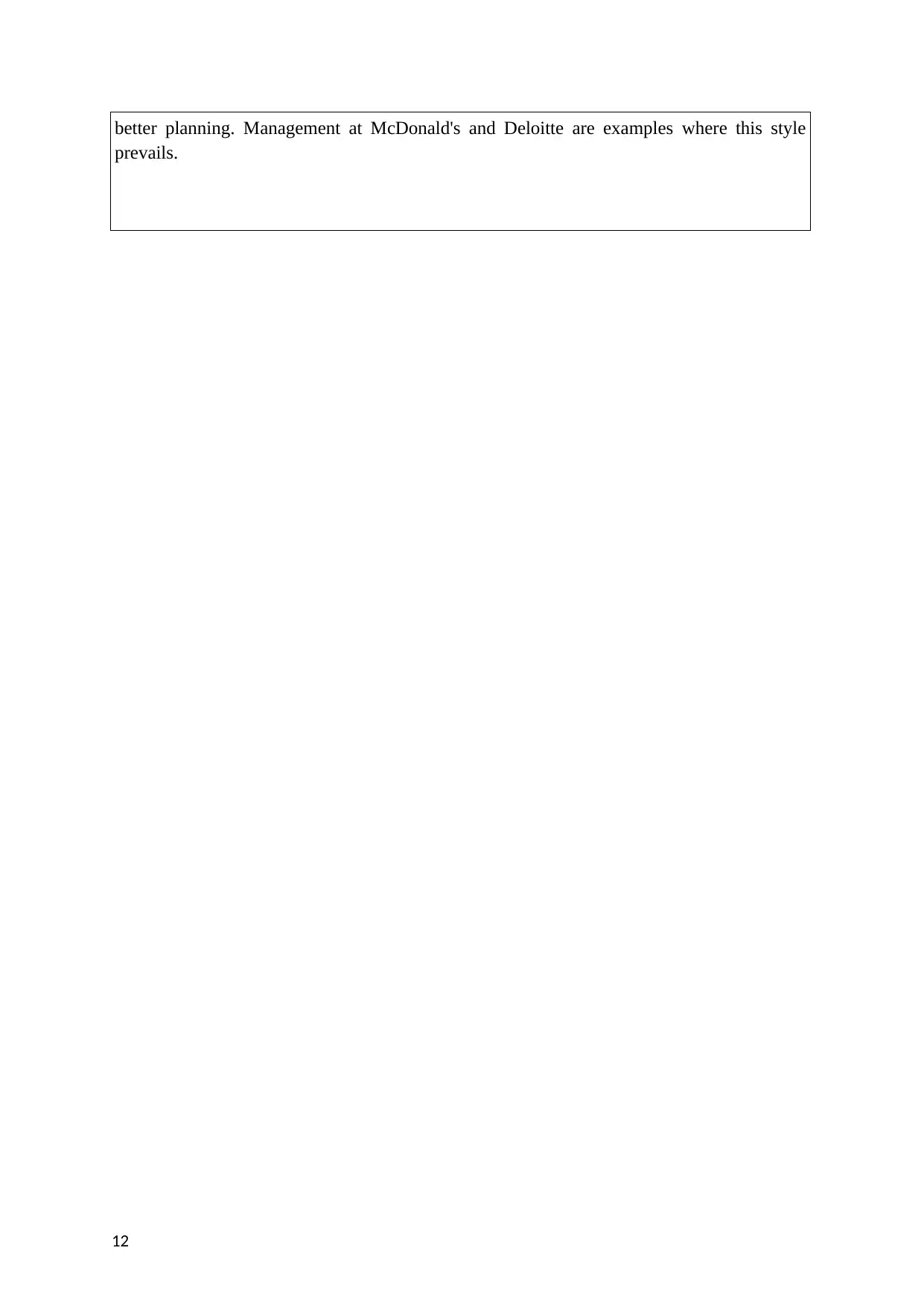
better planning. Management at McDonald's and Deloitte are examples where this style
prevails.
12
prevails.
12
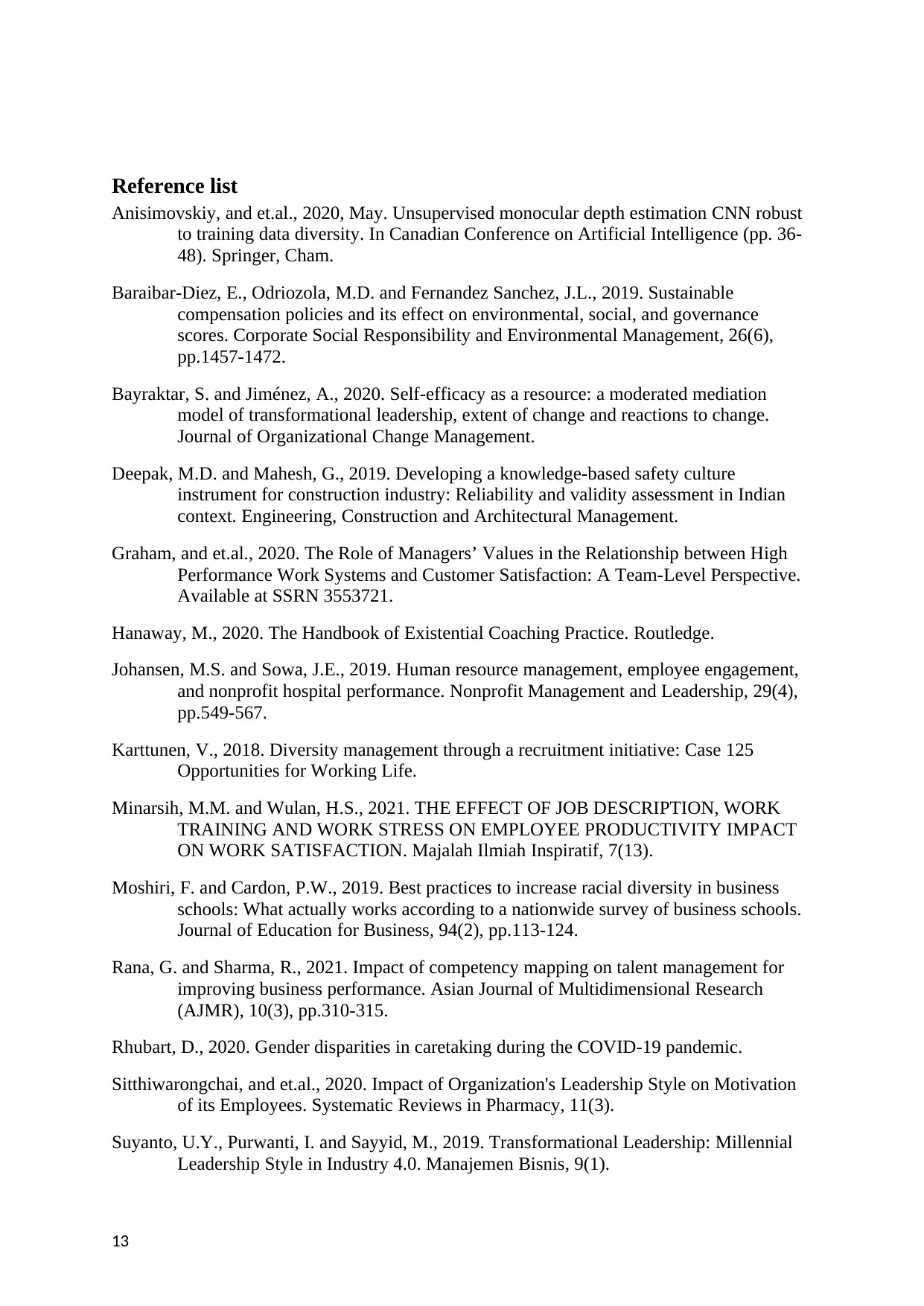
Reference list
Anisimovskiy, and et.al., 2020, May. Unsupervised monocular depth estimation CNN robust
to training data diversity. In Canadian Conference on Artificial Intelligence (pp. 36-
48). Springer, Cham.
Baraibar‐Diez, E., Odriozola, M.D. and Fernandez Sanchez, J.L., 2019. Sustainable
compensation policies and its effect on environmental, social, and governance
scores. Corporate Social Responsibility and Environmental Management, 26(6),
pp.1457-1472.
Bayraktar, S. and Jiménez, A., 2020. Self-efficacy as a resource: a moderated mediation
model of transformational leadership, extent of change and reactions to change.
Journal of Organizational Change Management.
Deepak, M.D. and Mahesh, G., 2019. Developing a knowledge-based safety culture
instrument for construction industry: Reliability and validity assessment in Indian
context. Engineering, Construction and Architectural Management.
Graham, and et.al., 2020. The Role of Managers’ Values in the Relationship between High
Performance Work Systems and Customer Satisfaction: A Team-Level Perspective.
Available at SSRN 3553721.
Hanaway, M., 2020. The Handbook of Existential Coaching Practice. Routledge.
Johansen, M.S. and Sowa, J.E., 2019. Human resource management, employee engagement,
and nonprofit hospital performance. Nonprofit Management and Leadership, 29(4),
pp.549-567.
Karttunen, V., 2018. Diversity management through a recruitment initiative: Case 125
Opportunities for Working Life.
Minarsih, M.M. and Wulan, H.S., 2021. THE EFFECT OF JOB DESCRIPTION, WORK
TRAINING AND WORK STRESS ON EMPLOYEE PRODUCTIVITY IMPACT
ON WORK SATISFACTION. Majalah Ilmiah Inspiratif, 7(13).
Moshiri, F. and Cardon, P.W., 2019. Best practices to increase racial diversity in business
schools: What actually works according to a nationwide survey of business schools.
Journal of Education for Business, 94(2), pp.113-124.
Rana, G. and Sharma, R., 2021. Impact of competency mapping on talent management for
improving business performance. Asian Journal of Multidimensional Research
(AJMR), 10(3), pp.310-315.
Rhubart, D., 2020. Gender disparities in caretaking during the COVID-19 pandemic.
Sitthiwarongchai, and et.al., 2020. Impact of Organization's Leadership Style on Motivation
of its Employees. Systematic Reviews in Pharmacy, 11(3).
Suyanto, U.Y., Purwanti, I. and Sayyid, M., 2019. Transformational Leadership: Millennial
Leadership Style in Industry 4.0. Manajemen Bisnis, 9(1).
13
Anisimovskiy, and et.al., 2020, May. Unsupervised monocular depth estimation CNN robust
to training data diversity. In Canadian Conference on Artificial Intelligence (pp. 36-
48). Springer, Cham.
Baraibar‐Diez, E., Odriozola, M.D. and Fernandez Sanchez, J.L., 2019. Sustainable
compensation policies and its effect on environmental, social, and governance
scores. Corporate Social Responsibility and Environmental Management, 26(6),
pp.1457-1472.
Bayraktar, S. and Jiménez, A., 2020. Self-efficacy as a resource: a moderated mediation
model of transformational leadership, extent of change and reactions to change.
Journal of Organizational Change Management.
Deepak, M.D. and Mahesh, G., 2019. Developing a knowledge-based safety culture
instrument for construction industry: Reliability and validity assessment in Indian
context. Engineering, Construction and Architectural Management.
Graham, and et.al., 2020. The Role of Managers’ Values in the Relationship between High
Performance Work Systems and Customer Satisfaction: A Team-Level Perspective.
Available at SSRN 3553721.
Hanaway, M., 2020. The Handbook of Existential Coaching Practice. Routledge.
Johansen, M.S. and Sowa, J.E., 2019. Human resource management, employee engagement,
and nonprofit hospital performance. Nonprofit Management and Leadership, 29(4),
pp.549-567.
Karttunen, V., 2018. Diversity management through a recruitment initiative: Case 125
Opportunities for Working Life.
Minarsih, M.M. and Wulan, H.S., 2021. THE EFFECT OF JOB DESCRIPTION, WORK
TRAINING AND WORK STRESS ON EMPLOYEE PRODUCTIVITY IMPACT
ON WORK SATISFACTION. Majalah Ilmiah Inspiratif, 7(13).
Moshiri, F. and Cardon, P.W., 2019. Best practices to increase racial diversity in business
schools: What actually works according to a nationwide survey of business schools.
Journal of Education for Business, 94(2), pp.113-124.
Rana, G. and Sharma, R., 2021. Impact of competency mapping on talent management for
improving business performance. Asian Journal of Multidimensional Research
(AJMR), 10(3), pp.310-315.
Rhubart, D., 2020. Gender disparities in caretaking during the COVID-19 pandemic.
Sitthiwarongchai, and et.al., 2020. Impact of Organization's Leadership Style on Motivation
of its Employees. Systematic Reviews in Pharmacy, 11(3).
Suyanto, U.Y., Purwanti, I. and Sayyid, M., 2019. Transformational Leadership: Millennial
Leadership Style in Industry 4.0. Manajemen Bisnis, 9(1).
13
Paraphrase This Document
Need a fresh take? Get an instant paraphrase of this document with our AI Paraphraser
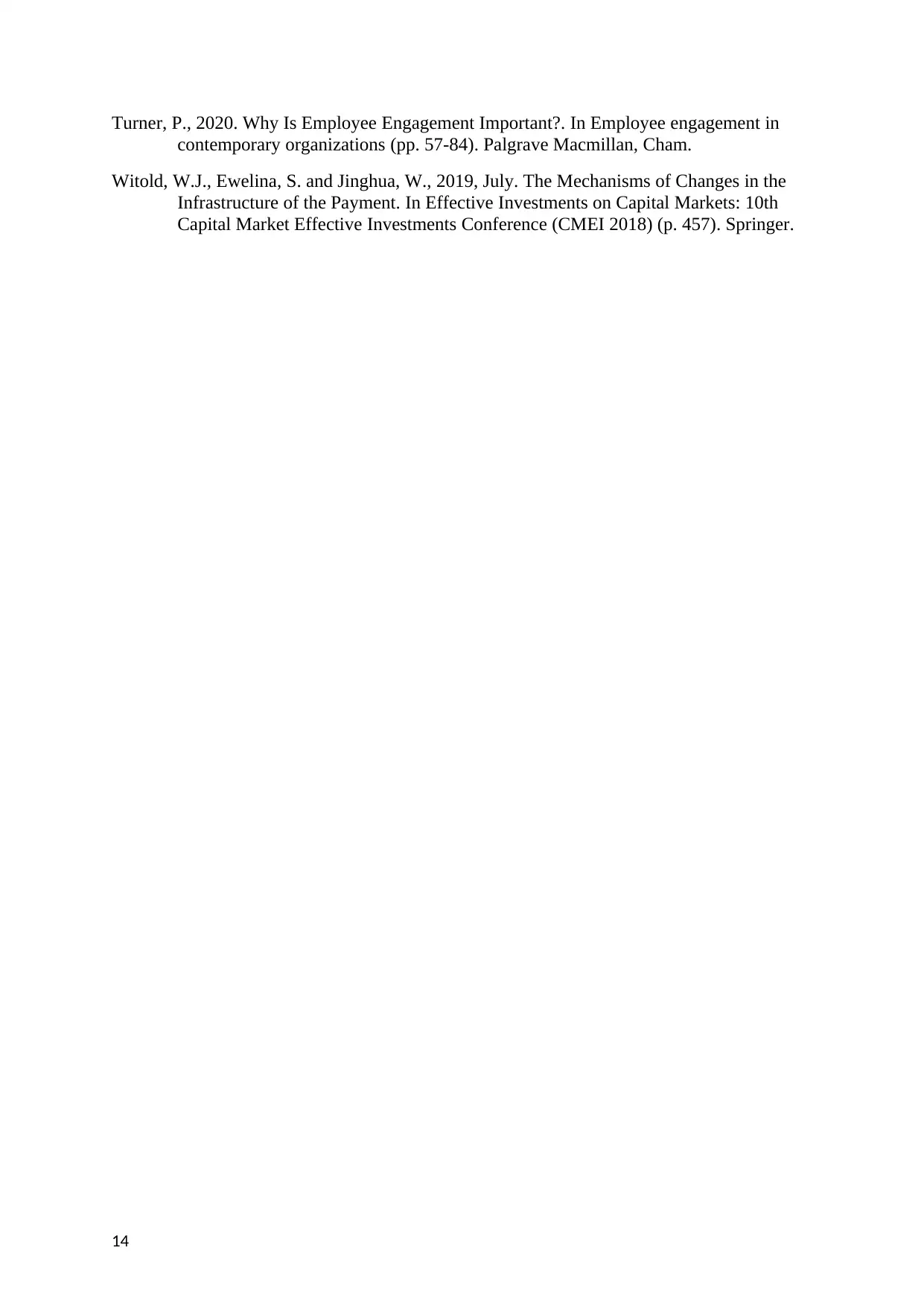
Turner, P., 2020. Why Is Employee Engagement Important?. In Employee engagement in
contemporary organizations (pp. 57-84). Palgrave Macmillan, Cham.
Witold, W.J., Ewelina, S. and Jinghua, W., 2019, July. The Mechanisms of Changes in the
Infrastructure of the Payment. In Effective Investments on Capital Markets: 10th
Capital Market Effective Investments Conference (CMEI 2018) (p. 457). Springer.
14
contemporary organizations (pp. 57-84). Palgrave Macmillan, Cham.
Witold, W.J., Ewelina, S. and Jinghua, W., 2019, July. The Mechanisms of Changes in the
Infrastructure of the Payment. In Effective Investments on Capital Markets: 10th
Capital Market Effective Investments Conference (CMEI 2018) (p. 457). Springer.
14

Appendices
15
15
1 out of 15
Related Documents
Your All-in-One AI-Powered Toolkit for Academic Success.
+13062052269
info@desklib.com
Available 24*7 on WhatsApp / Email
![[object Object]](/_next/static/media/star-bottom.7253800d.svg)
Unlock your academic potential
© 2024 | Zucol Services PVT LTD | All rights reserved.


